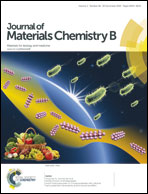Graphene–polydopamine–C60 nanohybrid: an efficient protective agent for NO-induced cytotoxicity in rat pheochromocytoma cells†
Abstract
Here we have designed and developed a facile and mild synthetic approach to prepare a graphene–polydopamine–C60 nanohybrid for biological applications. Graphene oxide (GO) is surface modified and reduced via polydopamine (PDA) chemistry. Using nucleophilic addition, the rGO–PDA–C60 nanohybrid is then prepared. Benefiting from the unique nanostructure, the versatile hybrid of rGO–PDA–C60 limits the aggregation of C60 and enhances the cell uptake, which displays synergistic protective effects on the NO-induced cytotoxicity. Investigation of the possible NO-scavenging activities of rGO–PDA–C60 demonstrates that it expresses direct scavenging activity toward NO both under cell and cell free conditions. As expected, rGO–PDA–C60 prevents NO-induced cytotoxicity and blocks the following apoptosis events, such as lipid peroxidation, mitochondrial depolarization, and caspase-3 activation. The study presents the potential of nanocarbons for preventing the NO-mediated cell injury.


 Please wait while we load your content...
Please wait while we load your content...